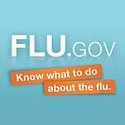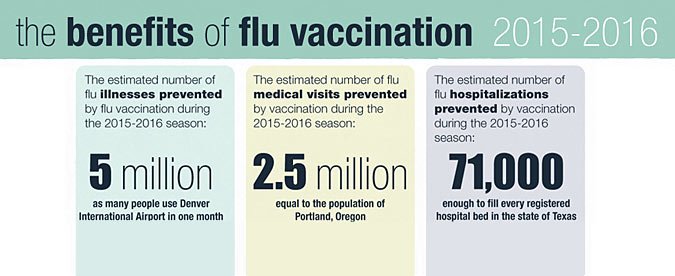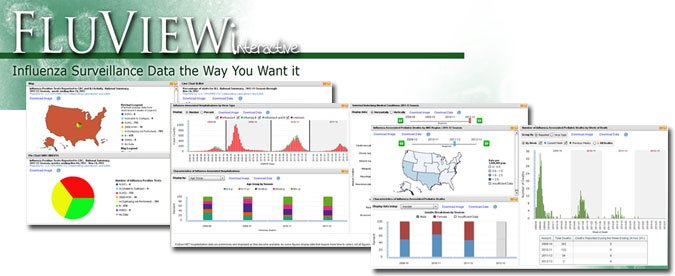Influenza activity is still rising in the U.S. and is expected to continue for several weeks.
CDC recommends a yearly flu vaccine for everyone 6 months and older. This season's flu vaccines are reducing risk of illness by nearly half. Anyone who had not yet gotten vaccinated this season, should do it now.
CDC also recommends prompt treatment with influenza antiviral drugs for people who are very sick with flu or people who are at high risk of flu illness who get flu.
-
Flu Basics
Symptoms, How Flu Spreads, Higher Risk Groups, Past and Current Flu Season -
Prevention - Flu Vaccine
Vaccine Safety, Vaccination Coverage, Influenza VIS, NIVW, Infection Control -
Treatments
Drugs to Treat Flu Virus, Stay Home When Sick, Caring for Someone Sick With Flu -
Supply and Distribution
Approved U.S. Flu Vaccines, Total Doses Distributed -
News & Highlights
Flu Spotlights, Press Releases…
-
Health Professionals
Vaccination, Antiviral Drugs, Infection Control, Diagnostic Testing, and Training -
Free Resources
Printable Materials, Photos, Podcasts, Videos, PSAs, eCards, Badges & Buttons, Articles -
Information For Partners
Campaign Highlights, Partner Activity, Media Briefings, Promotional/Educational Tools -
Questions & Answers
Answers to Flu-Related Questions -
Public Health Image Library
Photographs, Illustrations, and Multimedia Files
Other Flu Web Sites
There are many different influenza A viruses; some are found in humans and others in animals such as avian flu in birds and poultry.
U.S. H5 Viruses: Highly pathogenic avian influenza (HPAI) H5 infections have been reported in U.S. birds and poultry. No human infections with these viruses have been detected at this time, however similar viruses have infected people in other countries and caused serious illness and death in some cases.
There are many different influenza A viruses; some are found in humans and others in animals such as swine flu in pigs.
CDC’s pandemic preparedness efforts include ongoing surveillance of human and animal influenza viruses, risk assessments of influenza viruses with pandemic potential, and the development and improvement of preparedness tools that can aid public health practitioners in the event of an influenza pandemic.
Bat influenza refers to influenza A viruses found in bats. Laboratory research at CDC suggests these viruses would need to undergo significant changes to become capable of infecting and spreading easily among humans. Little yellow shouldered bats are not native to the continental United States, but are common in Central and South America.
Dog flu is a contagious respiratory disease in dogs caused by a specific Type A influenza virus referred to as a “canine influenza virus.” This is a disease of dogs, not of humans.
Influenza A viruses are found in humans and many different animals, including ducks, chickens, pigs, whales, horses and seals. Additional information on 2009 H1N1 influenza, Flu.gov, and Nonpharmaceutical Interventions (NPIs).
 Looking for Flu.gov? It has been retired. CDC provides content related to seasonal and other influenza viruses, including pandemic flu.
Looking for Flu.gov? It has been retired. CDC provides content related to seasonal and other influenza viruses, including pandemic flu.
Flu Activity & Surveillance
International Flu
 The latest report on CDC's international flu activities highlights the progress that has been made over the past two fiscal years in establishing, expanding and maintaining influenza surveillance and laboratory capacity in more than 50 countries around the world where CDC has provided support.
The latest report on CDC's international flu activities highlights the progress that has been made over the past two fiscal years in establishing, expanding and maintaining influenza surveillance and laboratory capacity in more than 50 countries around the world where CDC has provided support.
What's New
- Situation Update: Summary of Weekly FluView Report Friday, February 24, 2017
- FluView - Weekly Influenza Surveillance Report Friday, February 24, 2017
- Update: Influenza Activity — United States, October 2, 2016–February 4, 2017 Friday, February 17, 2017
- Interim Estimates of 2016–17 Seasonal Influenza Vaccine Effectiveness — United States, February 2017 Friday, February 17, 2017
- CDC Reports This Season’s Flu Vaccine Reducing Risk by Nearly Half Thursday, February 16, 2017
- Page last reviewed: March 3, 2017
- Page last updated: March 3, 2017
- Content source:
- Centers for Disease Control and Prevention, National Center for Immunization and Respiratory Diseases (NCIRD)
- Page maintained by: Office of the Associate Director for Communication, Digital Media Branch, Division of Public Affairs


 ShareCompartir
ShareCompartir




